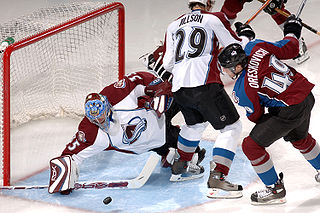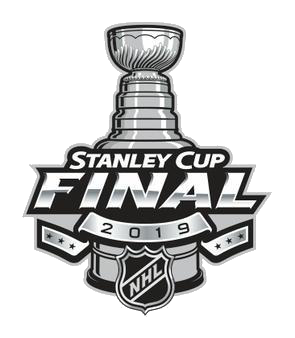
Ice hockey is a team sport played on ice skates, usually on an ice skating rink with lines and markings specific to the sport. It belongs to a family of sports called hockey. In ice hockey, two opposing teams use ice hockey sticks to control, advance, and shoot a closed, vulcanized, rubber disc called a "puck" into the other team's goal. Each goal is worth one point. The team which scores the most goals is declared the winner. In a formal game, each team has six skaters on the ice at a time, barring any penalties, one of whom is the goaltender. Ice hockey is a full contact sport, and is considered to be one of the more physically demanding team sports. It is distinct from field hockey, in which players move a ball around a non-frozen pitch using field hockey sticks.

In ice hockey, a goal is scored when the puck entirely crosses the goal line between the two goal posts and below the goal crossbar. A goal awards one point to the team attacking the goal scored upon, regardless of which team the player who actually deflected the puck into the goal belongs to. Typically, a player on the team attempting to score shoots the puck with their stick towards the goal net opening, and a player on the opposing team called a goaltender tries to block the shot to prevent a goal from being scored against their team.
Short-handed is a term used in ice hockey and several related sports, including water polo, and refers to having fewer players on the ice during play, as a result of a penalty. The player removed from play serves the penalty in the penalty box for a set amount of time proportional to the severity of the infraction. If a goaltender commits a minor infraction, another player who was on the ice at the time of the penalty serves, often but not necessarily the team captain.

In ice hockey, the goaltender is the player responsible for preventing the hockey puck from entering their team's net, thus preventing the opposing team from scoring. The goaltender mostly plays in or near the area in front of the net called the goal crease. Goaltenders tend to stay at or beyond the top of the crease to cut down on the angle of shots. In the modern age of goaltending there are two common styles, butterfly and hybrid. Because of the power of shots, the goaltender wears special equipment to protect the body from direct impact.

A penalty in ice hockey is a punishment for an infringement of the rules. Most penalties are enforced by sending the offending player to a penalty box for a set number of minutes. During the penalty the player may not participate in play. Penalties are called and enforced by the referee, or in some cases, the linesman. The offending team may not replace the player on the ice, leaving them short-handed as opposed to full strength. When the opposing team is said to be on a power play, they will have one more player on the ice than the short-handed team. The short-handed team is said to be "on the penalty kill" until the penalty expires and the penalized player returns to play. While standards vary somewhat between leagues, most leagues recognize several common varieties of penalties, as well as common infractions.
In ice hockey, a penalty shot is a type of penalty awarded when a team loses a clear scoring opportunity on a breakaway because of a foul committed by an opposing player. A player from the non-offending team is given an attempt to score a goal without opposition from any defending players except the goaltender. This is the same type of shot used in a shootout to decide games in some leagues.
Overtime is a method of determining a winner in an ice hockey game when the score is tied after regulation. The main methods of determining a winner in a tied game are the overtime period, the shootout, or a combination of both. If league rules dictate a finite time in which overtime may be played, with no penalty shoot-out to follow, the game's winning team may or may not be necessarily determined.

Roller in-line hockey, American roller hockey or inline hockey, is a variant of hockey played on a hard, smooth surface, with players using inline skates to move and ice hockey sticks to shoot a hard, plastic puck into their opponent's goal to score points. The sport is a very fast-paced and free-flowing game and is considered a contact sport, but body checking is prohibited. There are five players including the goalkeeper from each team on the rink at a time, while teams normally consist of 16 players. There are professional leagues, one of which is the National Roller Hockey League (NRHL). While it is not a contact sport, there are exceptions, i.e. the NRHL involves fighting.
The following are statistics commonly tracked in ice hockey.

Cecil Ralph "Tiny" Thompson was a Canadian professional ice hockey goaltender. He played 12 seasons in the National Hockey League (NHL), first for the Boston Bruins, and later for the Detroit Red Wings. A four-time Vezina Trophy winner, Thompson was inducted into the Hockey Hall of Fame in 1959. He was a member of one Stanley Cup-winning team, as a rookie in the 1928–29 season with the Boston Bruins. At the start of the 1938–39 season, after ten full seasons with Boston, he was traded to the Detroit Red Wings, where he completed the season, and played another full one before retiring. During his NHL career, he recorded 81 shutouts, the sixth-highest of any goaltender. After retiring from playing, he coached lower-league teams before becoming a noted professional scout. Thompson helped popularize the technique of the "glove save" which was catching the puck with his hands as a method of making a save. A competent puckhandler, he was the first goaltender in the NHL to record an assist in 1936 by passing the puck with his stick to a fellow player.
The 1927–28 NHL season was the 11th season of the National Hockey League. Ten teams played 44 games each. The New York Rangers won the Stanley Cup beating the Montreal Maroons, becoming the first NHL team based in the United States to win it.
The season structure of the National Hockey League (NHL) is divided into the pre-season, regular season, and the Stanley Cup playoffs. In the pre-season, which is generally held during the last two weeks of September, each team plays several not-for-the-record exhibition games. In the regular season, which generally runs from early October through early April, teams play 82 games which determine their standings. The three highest-placed teams in each division and two wild card teams per conference enter the playoff elimination tournament to determine the Stanley Cup champion.

The National Hockey League rules are the rules governing the play of the National Hockey League (NHL), a professional ice hockey organization. Infractions of the rules, such as offside and icing, lead to a stoppage of play and subsequent face-offs, while more serious infractions lead to penalties being assessed to the offending team. The league also determines the specifications for playing equipment used in its games.
This is a list of common terms used in the sport of ice hockey along with the definitions of these terms.

An empty net goal, abbreviated as EN or ENG and colloquially called an empty netter, occurs in several team sports when a team scores a goal into a net with no goaltender (goalie) present.
In ice hockey, an awarded goal is an unusual situation in which a goal is awarded to a team rather than scored. A penalty shot is a type of penalty awarded when a team loses a clear scoring opportunity on a breakaway because of a foul committed by an opposing player. A player from the non-offending team is given an attempt to score a goal without opposition from any defending players except the goaltender. However, when such a lost opportunity occurs and the opposing team has pulled its goalie to allow for an extra attacker, a goal is simply awarded without a penalty shot taking place.

The 2013 Stanley Cup Finals was the championship series of the National Hockey League's (NHL) 2012–13 season, and the conclusion of the 2013 Stanley Cup playoffs. The Western Conference playoff champion Chicago Blackhawks defeated the Eastern Conference playoff champion Boston Bruins in six games to win their fifth Stanley Cup in team history. The Blackhawks also became just the eighth team to win both the Cup and the Presidents' Trophy in the same season. Chicago's Patrick Kane was awarded the Conn Smythe Trophy as the Most Valuable Player of the playoffs.

The 2014 Stanley Cup playoffs was the playoff tournament of the National Hockey League (NHL) for the 2013–14 season. They began on April 16, 2014, and ended June 13, 2014, when the Los Angeles Kings defeated the New York Rangers four games to one in the Stanley Cup Finals.

The 2019 Stanley Cup Finals was the championship series of the National Hockey League's (NHL) 2018–19 season and the culmination of the 2019 Stanley Cup playoffs. The Western Conference champion St. Louis Blues defeated the Eastern Conference champion Boston Bruins four games to three in the best-of-seven series. It was the Blues' first championship, in their 51st season of play, ending what was then the third-longest championship drought in league history. The Bruins had home-ice advantage in the series with the better regular season record. The series began on May 27 and concluded on June 12. The Blues' Stanley Cup–winning run of 26 playoff games tied the 2014 Los Angeles Kings for the longest of any Stanley Cup–winning team in history.










